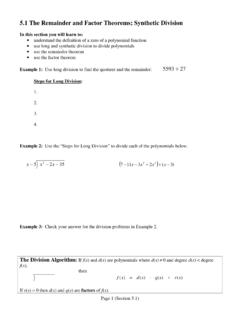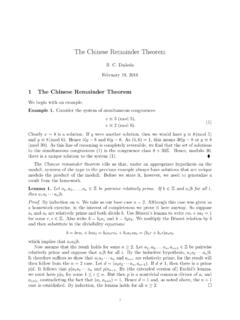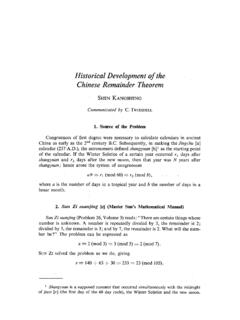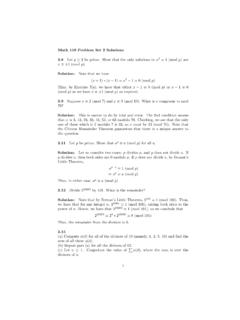Transcription of The Integral Form of the Remainder in Taylor’s Theorem ...
1 TheIntegralFormof the Remainderin taylor 'sTheoremMATH 141 HJonathanRosenbergApril24, 2006 Letfbe a smooth functionnearx= 0. Forxcloseto 0, we can writef(x) in termsoff(0) by usingthe Fundamental Theoremof Calculus:f(x) =f(0) +Zx0f0(t)dt:Now integrateby parts,settingu=f0(t),du=f00(t)dt,v=t x,dv=dt. (Remember,the variableof integrationist, and we're thinkingofxas a constant.) We getf(x) =f(0) +Zx0f0(t)dt=f(0) + (t x)f0(t) t=xt=0 Zx0(t x)f00(t)dt=f(0) +xf0(0) Zx0(t x)f00(t)dt:Now repeat the ,integrateby parts,this timewithu=f00(t),du=f000(t)dt,v= (t x)2=2,dv= (t x)dt.
2 We getf(x) =f(0) +xf0(0) Zx0(t x)f00(t)dt=f(0) h(t x)22f00(t)it=xt=0+Zx0(t x)22f000(t)dt=f(0) +xf0(0) +x22f00(0) +Zx0(t x)22f000(t)dt:1 Continuingthis processover and over, we see eventuallythatf(x) =f(0) +xf0(0) + +xnn!f(n)(0) +Rn(x)wherethe remainderRn(x) is given by the formulaRn(x) = ( 1)nZx0(t x)nn!f(n+1)(t)dt=Zx0(x t)nn!f(n+1)(t)dt:In principlethisis an exactformula,but in practiceit's usuallyimpossibleto , let'sassumefor simplicity thatx >0 (thecasex <0 is similar)and assumethata f(n+1)(t) b;0 t x:In otherwords,ais a lower boundforf(n+1)(t) on the interval [0; x], andbis an upper boundforf(n+1)(t) on the sameinterval.
3 Thenwe getZx0(x t)nn!a dt Rn(x) =Zx0(x t)nn!f(n+1)(t)dt Zx0(x t)nn!b dt:( )ButZx0(x t)nn!dt= ( 1)nZx0(t x)nn!dt= ( 1)nh(t x)n+1(n+ 1)!it=xt=0= ( 1)nh0(n+ 1)! ( x)n+1(n+ 1)!i= ( 1)n( 1)n+1xn+1(n+ 1)!=xn+1(n+ 1)!:Pluggingthis into ( ), we see thataxn+1(n+ 1)! Rn(x) bxn+1(n+ 1)!;which is Lagrange'sestimatefor the
















